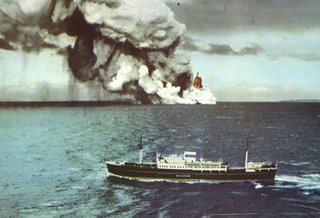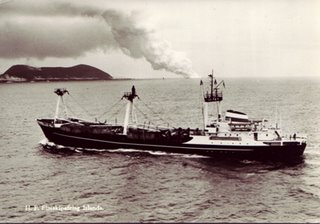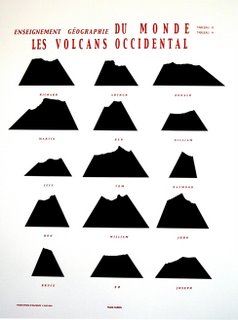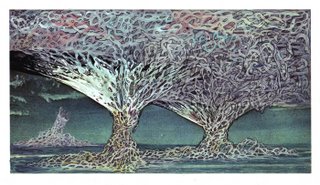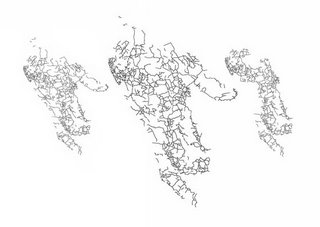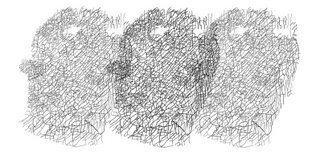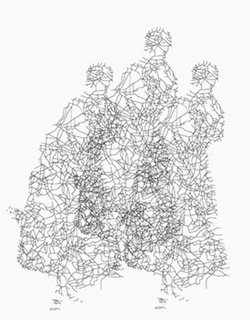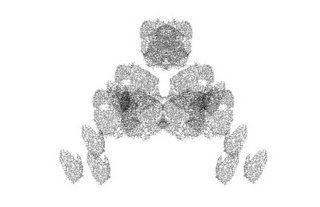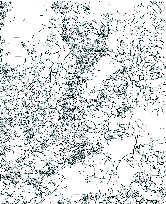Monday, October 30, 2006
'V'Three
Drawing- Negative- Print
White- black- Orange
You- Me- It
The triangle, the triangle of triangles has got me thinking, got me playing got me here.
I'm in Oslo, not there not home. I'm still drawing them. It'a a road straight converging to the horizon, it's also a cap for the dunce.
White- black- Orange
You- Me- It
The triangle, the triangle of triangles has got me thinking, got me playing got me here.
I'm in Oslo, not there not home. I'm still drawing them. It'a a road straight converging to the horizon, it's also a cap for the dunce.
Monday, October 23, 2006
Joe Hanly (DIT) Tiangle Project
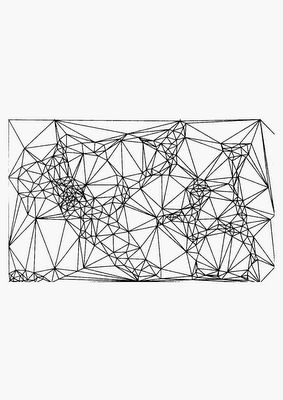
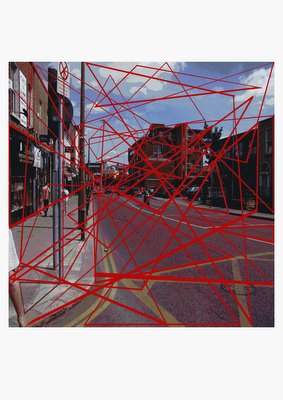
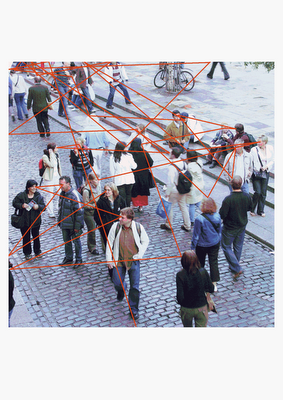
A Triangulational Aesthetic
This project has, surprisingly enough, afforded me a welcome opportunity to talk about triangles, something, until now, I would never have been caught dead doing, in spite of the fact that I’ve always had a special place in my art fort a triangle or two. For me the triangle has helped as a kind of thinking device for working my way through or around problems. As I saw it, a problem often consisted of two competing components finding themselves together in a contested space getting no further than a frustrated and often static impasse alleviated only when an appropriate third component is identified and introduced into the mix. It would become a “ménage a trois” in which each component would act as a catalyst for the other two to reveal themselves in a full and active dynamic. This triangular relationship has served as a device for realising work and for identifying the nature of its discourse. It has informed my teaching practice and proved a valuable aid to the setting of course projects. It has also functioned as a type of mental drawing for use not only to negotiate my own work but also to negotiate real life situations out in the big world. In fact, if really pushed, the “ménage a trois’ can be projected onto any situation one cares to think about. Now I keep finding triangles in spaces I didn’t even know had angles.
When starting out on this Triangle Project for want of something better to do I decided to take the word itself and play about with it in order to see what it might throw out. Among the words I came up with were triangulationship, striangulation, entrianglement etc but the word, which returned something more engaging, when googled, was “Triangulation”. Although used in statistical analyses and in navigation, more interestingly for me this word revealed “Delauny’s Triangulation” a system, invented in 1943 by a Russian mathematician Boris Delauney, for taking complex geometric objects and breaking them down into their simplest possible geometric object which is the triangle. This is now apparently one of the main techniques used to create 3D computer graphics. Although not appearing, as yet directly, applicable to anything here the resulting drawings of this process seems to offer a flexible structure ideal for a visual approximation of what I consider to be mental drawing.
While trying to ponder life’s enigmas over the years there were a number of writers that interested me, whose work required some serious mental drawing in order to get a handle on it. Amongst these there were a few obvious suspects such as Derrida, Barthes and Chomsky. Triangles of varying complexities were required in order to come to terms with such works as Roland Barthes’s “Mythologies” with its references to the Signified, Signifier and Sign as it multiplied into multilayered triangular readings of cultural situations and historic events and Jaques Derrida’s endless deferral of meaning back through other meanings and traces of meanings in “Margins of Philosophy” and his deconstruction of western cannons of truth established throughout a logo-centric tradition of binary oppositions. Also in the not so triangular Naom Chomsky’s “Universal Grammar”, in which he suggests that there is a universally innate and complex grammatical scaffolding that grows in the mind/brains of children, autonomous of environmental conditions but in tune with their biological development, in order to handle the vocabulary that they are acquiring no matter where in the world they come from. Finally, late to this group, comes Edward Soja, social geographer and a true man of the triangle, of whom I have become come aware more recently, who in his book “Thirdspace” has enlisted Henri Lefebvre, of, one time, situationist fame, in taking Hegel’s dialectic and reconstituting it into a spatial trialectic. To this intensive bout of mental drawing comes Delauney’s Triangulation, which provide an intricate visual system that, for me, seems to fit it all like a glove. (image 1)
”Delauny’s Triangulation” interactive site, worth checking out:
< http://www.cs.cornell.edu/Info/People/chew/Delaunay.html >
One of those triangles, that I keep finding everywhere, I have found in a space, more commonly frequented by psychologists, political and historical analysts and perhaps even social geographers but it is a space that is not totally unknown to the odd self-opinionated artist either. The triangle is situated within a three-way relationship of traits basic to the nature of an individual’s personality. It is a “Holy Trinity” of the psyche that consists of (a) A rational component (b) An intuitive component and (c) An Instinctive component. In this triangular relationship, a, b and c make up the triangle and the personality is positioned within it, like a pointer in a triangular colour palette of some graphics software, benefiting proportionately from each of (a) the rational, (b) the intuitive and (c) the instinctive. This is certainly not the most complete or accurate picture of what happens but its not too far off either and it is sufficient for my purposes here. I find that that basic triangular arrangement of traits has a very interesting outcome when it is taken from the micro situation of the individual psyche and is projected onto the macro situation of the collective psyche. There you can have such threesomes as Politics, Commerce and Culture or things Material, Imaginary and Spiritual. You can also have such wonderful mixes as Totalitarianism, Democracy and Anarchy or Classical, Traditional and Contemporary; Realism, Idealism, Fantasy etc. My point here is that since these positions really actually only reflect human constructs or interpretations of society’s complex relationships, each of the components in a group is likely to bear a loose resemblance to a general personality type which would have been fundamental to its conception. In other words each position within a group would gravitate towards a particular type of personality and visa versa although always retaining something of the other types in the group too. Things begin to hot up when one component in a group becomes dominant over the others or more commonly when two components become so actively engaged in a struggle between each other that they are distracted from or forget about the possibility of a third component leaving it out in the cold to continue developing unobserved all on its own. This tends to happen in the logo centric world, described by Derrida, where every position is perceived as being in some natural binary opposition to another, like good and bad or black and white, where there are only grey areas that exist in between. However, in a trialectic world, although not quite that of Soja’s rather netherworldly “thirdspace”, every position might be in a tri-polar relationship like that of red, yellow and blue in the colour wheel (sorry triangle) with the space between being any one of a multiple of contrasting or complementary colours and shades.
One task might now be to find two apparently polar oppositions, which are locked in combat with each other, completely oblivious to the existence of a third component bubbling away in the background. (A classic example could be Left wing versus Right wing). Then assign to those components their appropriate personality traits within the triangle. When that is done try to identify a third component that will fit an alternative personality trait within that same mix. (So! In the case of the classic example above, what could the third component be? All suggestions welcome or any other banter at all. Be adventurous!).
Where does that now leave us? Nowhere really except that we end up with lots of lovely triangles strewn all over the place and the next time that an old reliable pendulum stops swinging in a predictable motion back and forth between two polar oppositions but swings erratically and unpredictably all over the place it is time to throw a spanner into the works. I think I feel a few squares coming on now.
With more modest intent, the triangular relationships in my work, produced for this project, “Entrianglement” (image 2.) are established between diverse elements, in the photograph of Rathgar/Rathmines junction, such as between an elbow, road markings and a cloud and in ”Triangleyes” (image 3) the relationship is between the eyes of those walking through Temple Bar Square. In this piece the relationship is not triangular but it produces lots of incidental triangles which open up further possibilities.
Friday, October 20, 2006
Nick Rodgers


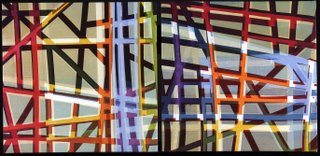
The triptych project arrived at an interesting time. I have been considering my practice and research for some time. I have been looking at various strands of my work and trying to consider if they are what I really want to do , or things that I think I should be doing.
So a project that encouraged me to consider my approach to drawing forced me to question , further, my practice,
I would say that most of my textile work has had an intuitive approach in terms of mark making and my use of colour. I respond to what I see, hear, think by working directly on textiles with dyes and inks.
At the same time I can identify that I am interested in the processes that I use to create work. I love printing, I love layering colour, I love experimenting with what I can do to fabric , I love trying to work out systems for economical printing, I love lots of things but I don’t always do them.
Why? sometimes fear.
What if it all goes wrong? What will people think?
The Triptych project has allowed me to develop ideas without the need to be prolific in my output. It has allowed me the time to think about ideas , discuss those ideas with peers and it has influenced some aspects of my teaching practice.
STARTING POINTS
the project started with a response to the triptych symbol. I considered this to be a basic triangle. the question was to consider my visual response to that shape or to consider the idea of my response having 3 facets.
I have previously been interested in producing images of stripes that are random but are generated in CAD. The stripes would be horizontal but would alter in width and colour.
having had conversations with Dr Hilary Carlisle of Edinburgh College of Art, I knew that this would be difficult. Her PHD dealt with random patternmaking in a textiles context. One of the main issues with the random generation of a recurring image is that it can become incredibly large or small. Therefore you have to build in upper and lower limits in the programming .i.e. the shape can be no smaller than x and no larger than y but within that limit it can be any size. You then have the issue of creating random generation of colours.
The first response was to start drawing triangles, or to be more accurate, approximations of triangles as none of the lines were straight. the shapes were connected to form larger shapes that were fairly random
These shapes could not be random as I was obviously making judgements about : the size of paper, where to start drawing, what direction to develop the image and most importantly when to stop.
What I was interested in was making the process more, if not completely, random.
The drawings that were created in the sketchbook started to resemble wire mapped drawings of semi recognisable organic forms. When anyone looked at the image there first comment was that it looked like a thing!.
when I started to create the next drawing this response was in my head so I started to see the images as some sort of creature. This was not what I wanted to achieve. I think these thoughts were influencing the decisions I was making when adding the next triangular element to the composition. Therefore there was, as is to be expected , a response to external influences and to my own instinctive sense of trying to read an image into the marks I was creating.
At this stage there was no indication if the drawings were a means to an end. There was no product or design solution in mind. The result could be 2d or 3D . What I was interested in was considering a new drawing process for me, but at the back of my mind there was the thought of creating some leatherwork that used my drawings as the pattern for some form of embossing.
The next set of conversations I had were with Claude Gerald, a friend with experience of using lasers and of creating some basic computer programming. We discussed the drawings I was creating and the fact that that I wanted to create drawings that had a greater random element. Most of the development of this project has been insular, that is to say I have deliberately not looked for reference to this approach to drawing. I felt I needed the time to consider the idea before looking at how others may have explored the concept. However, recently I have been drawn to the sports pages of national newspapers and have found that there is an interesting use of random process in the production of drawings. The Guardian has been producing graphics that show the level of passing, direction of passing etc in particular World Cup matches.
At the same time I started to discuss my work with Kerry Walton, lecturer at LUSAD,
We were both interested in the use of the Triptych symbol as a starting point for our drawings . We both have similar interests but take quite different approaches to our drawing. The discussions were helpful as much as a form of encouragement as well as a mechanism for reflection and critical appraisal.
The discussions with Claude led me to shift my ideas slightly. Instead of using CAD at the end to produce work that was developed from my drawings , I would now consider using cad to create the drawings. Using Photoshop or any of the graphic packages would keep me working at the same level and would only be a digital version of what I was creating in the sketchbook. To make the drawing have a greater level of randomness there would have to be a some programming created.
I created some experimental drawings using Photoshop . These drawings are an extension of what I was doing in the sketchbook. Instead of one layer that had created the illusion of 3D I was now starting to work in multiple layers. Taking the image, copying and adding a new layer where I might shift, slightly, the angle of the drawing. On top of this I was drawing a new layer.
What I realised was that I definitely wanted to create drawings that have a large random element in their production. What Claude and I discussed was how we could do this from scratch. The starting point was to draw a series of connected triangles on a grid. The grid would have an x and Y axis placed on it so that measurements could be taken. When the shape was drawn the three points of each triangle were recorded ( point 1=x, Y . point 2 = x, Y etc) each triangle was given a number and each line in the triangle was given a number .therefore each triangle in the shape could be recorded as a sequence of numbers and this sequence could be translated to computer programming that would then be able to visualise the shape that was drawn.
So the first triangle(T1) in illustration 9 can be represented as :
T1 = L1(P1-P2) + L2(P1-P3) = L3(P2-P3)
And this can be read as
T1 = 3/3-3/7 +3/3-7/3 + 3/7-7/3
With the first digit representing the X axis and the second digit representing the Y axis.
This basic system is then translated into the corrects sequence and inputted into the CAD programme “ visual Basic”
CHICKEN OR EGG?
Why translate what is already there to just reproduce it on a screen?
The idea was to figure out how to represent the triangular shapes in a nonvisual way. From this point one could programme the computer to create random drawings by indicating maximums and minimums for the x and Y values. One could also start to create the images in 3D by adding a Z axis .
What I have realised is that I still want to create ‘the drawings myself. I want ownership of them. I don’t want the mechanical machine creating the image I want it to translate the image.
Now that I have figured out, in a very basic way how to represent the shapes I have drawn (using numbers) the next stage will be for me to select numbers that will create the drawings.
I see this as a relevant method , for me , of creating the drawings in a more random way. I cant help linking it with music. If you gave me a sheet of musical notation paper and some basic symbols I could mark them on the lines but I would have no idea what they would sound like if played on an instrument. However if I made the marks in a variety of ways and heard them translated I would possibly be able to start understanding sequences of notes and be able to figure out how my marks were being translated. The same could be said for the method I am considering for creating my drawings. So how do I avoid this?
One method would be to create the series of numbers and not translate them until I had created a group of the “number drawings” therefore I would have no visual reference to respond to. Another method nay be to create one drawing that is a continuous number sequence. The advantages of both of these methods are that there may be mistakes; some of the triangles may not match up, the lines may be repeated.
This will also allow me time to reflect on how I want to represent the drawings, if I am using them as a means to an end ,if I want to use this method to create drawings using different basic shapes (squares , rectangles etc) or if I could respond to places and situations with “number drawings”. i.e. landscapes as a series of numbers.
the next stage is to start work on one sequence of numbers , aiming to produce a drawing that has a large number of triangles. The decisions will be whether the numbers or the translation, in the form of a print , will be the drawing and whether the drawing is the final outcome of my project.
Nick Rodgers
Lecturer in textiles
LUSAD
Thursday, October 19, 2006
Monday, October 16, 2006
Kerry Walton
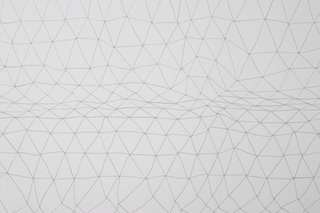
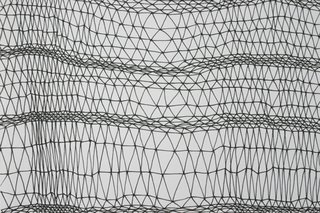
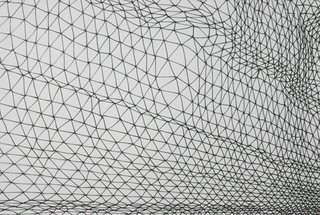
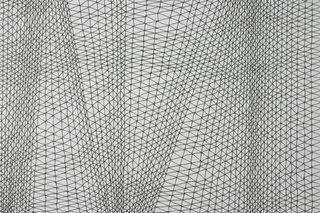
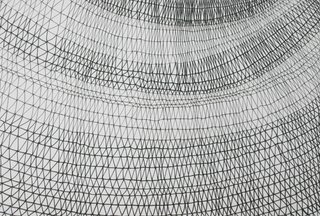
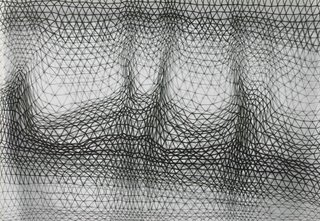
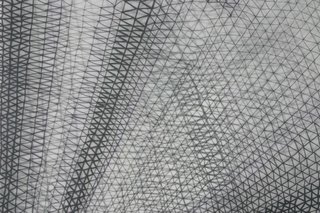
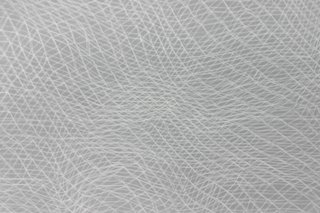
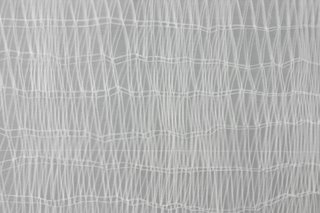
The images above represent the development of the Triptych project through a series of drawings which have explored the repeated use of the triangle symbol to create a range of net-like effects, using a range of drawing media. The most recent drawings have used layering techniques to build a more complex and 3 dimensional quality.
Background
For a number of year as a Textile designer I have been making prototype and sample pieces to be sold through agents or at Textile trade fairs. These designs have been variously directly translated by the manufacturer into production pieces or alternatively used as inspiration for the development of new ranges.
Drawing has always been part of the design process, a means to an end, and not the outcome. The outcomes have been the Textiles pieces, and a methodology has emerged involving the collection of imagery, and recording and analysing through drawing and photography. This visual research is then developed through a variety of processes, towards a textiles conclusion.These are often not literal interpretations of the research but develop a sense of the subject.
I have an interest in the structure and construction of the Texiles and the pieces tend not to be image based. My background in weaving has meant working within the restrictions of a process which is largely based on straight lines working in parallel with one another. There has always been a quality of drawing running through the pieces and thread is often used to create linear marks- a single thread creates a line, fibres create tonal effects. I frequently use restricted colour palettes – very often the inherent colour of the materials in their un-dyed state is sufficient: linen, cotton, silk, man made fibres, polythene and paper, concentrating on line, tone, effects of light and 3D surface qualities.
The Textile work has recently developed away from traditional boundaries of Textiles – Weave, Print and Embroidery and encompasses new processes such as heat bonding, laser cutting and multi-media approaches. These new processes have allowed me to develop the work without the constraints of a formal process – weaving – and to approach the work as drawing with Textile media – thread, fabric, stitch.
Re-occurring themes have been repetition, sequence, tonal gradation, shading and layering, and repetitive use of line and simple geometric forms. This is reflected and developed in the Triptych work where ideas have been allowed to develop through drawing without the urgency of processing quite quickly to a design stage.
Drawing has always been part of the design process, a means to an end, and not the outcome. The outcomes have been the Textiles pieces, and a methodology has emerged involving the collection of imagery, and recording and analysing through drawing and photography. This visual research is then developed through a variety of processes, towards a textiles conclusion.These are often not literal interpretations of the research but develop a sense of the subject.
I have an interest in the structure and construction of the Texiles and the pieces tend not to be image based. My background in weaving has meant working within the restrictions of a process which is largely based on straight lines working in parallel with one another. There has always been a quality of drawing running through the pieces and thread is often used to create linear marks- a single thread creates a line, fibres create tonal effects. I frequently use restricted colour palettes – very often the inherent colour of the materials in their un-dyed state is sufficient: linen, cotton, silk, man made fibres, polythene and paper, concentrating on line, tone, effects of light and 3D surface qualities.
The Textile work has recently developed away from traditional boundaries of Textiles – Weave, Print and Embroidery and encompasses new processes such as heat bonding, laser cutting and multi-media approaches. These new processes have allowed me to develop the work without the constraints of a formal process – weaving – and to approach the work as drawing with Textile media – thread, fabric, stitch.
Re-occurring themes have been repetition, sequence, tonal gradation, shading and layering, and repetitive use of line and simple geometric forms. This is reflected and developed in the Triptych work where ideas have been allowed to develop through drawing without the urgency of processing quite quickly to a design stage.
Triptych
The Triptych project has given me the opportunity to develop some of the themes apparent in my textile work and explore these through drawing.
I have been able to explore a more meaningful approach, without necessarily having to address function.
The project provides an opportunity, drawing provides a freedom un-restrained by commercial constraints and design considerations: is it on trend? is it what the buyers want? can it be commercially produced?
Sampling also rarely provides an opportunity to address issues of scale, but drawing will allow exploration of the ideas in a range of scale and media.
The next phase of the project will involve working in the same way I have been but making use of textile media.
The outcome will be a drawing response, using Textile media.
Recent drawings have begun to explore the potential for layers of similar imagery, and it is my intention to further these experiments through the use of fabric and stitch, transparency of some of the materials will allow for playing with space and light.
I am currently scanning the drawings and using Illustrator to generate files to operate laser cutting equipment to cut and mark the net effects onto a variety of textile grounds, and paper. Layers of laser cut fabric, paper and possibly other materials of different tone, density and transparency will be layered and stretched, stitched and printed to create a textile drawing which will be a piece in it’s own right, and not a fragment of a whole, nor intended for a specified Fashion or Interiors context.
Has working on this subject/theme altered your drawing process in any way?
The focus has been on the drawing and it's development, and drawing as an outcome rather than as part of a design process.
Has the idea of a possible collaborative outcome altered your thinking/working methods in any way?
The nature of collaboration has not really altered my approach, but I have used the opportunity to think more about the development of the work and less about a defined outcome.
How has the experience of your practice being reviewed and viewed by your peers in Triptych influenced the work?
That has not influenced the practice, however, I have made a conscious effort to organise the work in a kind of chronological sequence so that the development of the work can be followed without the need for accompanying text.
Have you discussed this piece of work/process with anyone else in Triptych while carrying out the work?
I have discussued the work on one occasion with Nick Rodgers, but so far it has been important for me to build up a body of drawing, and to gain confidence in this new approach before inviting discussion.
Has anything you saw at the Triptych IMMA symposium influenced your thinking or process in any way?
I did not attend the symposium.
What collaborative outcome would you suggest as being appropriate for this
research group?
I suggest that an exhibtion of the drawings and development work would best demonstrate the diversity of the project, and approaches through a variety of media and disciplines.
Wednesday, October 11, 2006
Simon's ∆ Submission
Dear Triptych Colleagues.
Anyone wishing to access my typographically inclined submission should click here. The submission is in the form of an Acrobat .pdf file which contains both the work and it's accompanying rationale.
Anyone wishing to access my typographically inclined submission should click here. The submission is in the form of an Acrobat .pdf file which contains both the work and it's accompanying rationale.
Monday, October 09, 2006
John Short DIT
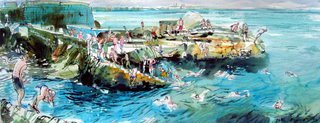
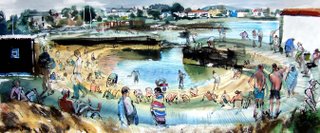

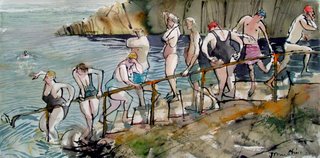



I have been working on a large series of bathers based on a local sea water pool at the Forty Foot Bathing Place in Sandycove, County Dublin over the last few years and exhibited the drawings and watercolours in a solo exhibition in a Dublin gallery last November. The works were all generated from quick direct observational sketchbook drawings. I aim to capture little fleeting moments. I then transfer these images later in the studio and build up complex scenes
of figures involved in lots of activity.
I have worked in some paintings with 30-40 little figures and alternatively worked on drawings with just a couple, chatting, dressing ,drying and so on and have begun transfering these glimpses into 3D drawings (I say this rather than sculptures) The triptytch structure I have created ties in with the triptych idea as a solid hinged piece of decorated furniture. A pierced hinged screen from one simple piece of card incorporating the idea of using 3 figures (rather than 2) I feel is more of what my intentions are in creating a sense of a social activity. I will use these macquettes to experiment on a larger scale and in sheet metal for my next exhibition next year.
Liz Minichiello
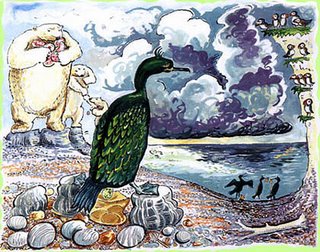

through this project I have explored the gap between text and image, and I have looked at reader interaction to picture storybooks. The process is not linear. Expectation created by the page element relationships demands and thus stimulates higher cognitive awareness.
One of things I have found useful in working with other artists is to look at how we convey message and meaning and to think again about how I use text and image.
Thursday, October 05, 2006
Leo Duff (KU) Stone Upon Broken Stone
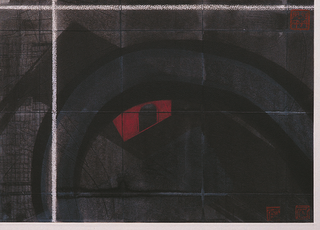
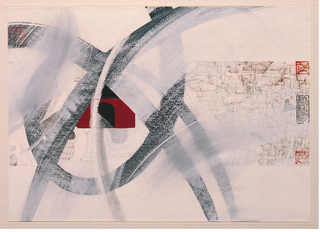

Stone Upon Broken Stone
Stone Upon Broken Stone was a phrase I saw high up on a long side wall of the vast Guinness brewery in Dublin in 1981. The words stayed with me as a type of memorial for that area of Dublin - St James Gate and The Liberties - and all of the ways of life they represented over many centuries. From early man through Viking invasions, the poverty associated with living outside the edge of the old city walls (known as the Liberties) and the phenomenon which is Guinness itself and its world wide distribution making the name St James Gate known across and in even the remotest parts of the globe. The constant demolition and rebuilding and the waxing and waning of the use of buildings in many parts of Ireland are a long term theme in my work. Stone Upon Broken Stone sums this up perfectly, and as my travels increased, became the expression which described the way I have been looking at mans use and reuse of stone and other building materials in Southern and Northern Ireland, the Boarders in Scotland, Croatia, Montenegro, Taiwan, The Peoples Republic of China, Mumbai and New Delhi in India, Byblos and Beirut in Lebanon, and Seoul in South Korea. Stone Upon Broken Stone also takes on a political edge when seen in the light of the changes which have occurred in the places people live and how they have relocated under the influence of change. Change for the better or change for the worse is not my theme however, it is the way change has affected the ways of building and rebuilding the ordinary places we inhabit.
As a whole, Stone Upon Broken Stone looks at the application of materials in buildings which are part of our normal lives, rather than grandiose or monumental architecture. The use, re-use and application of natural and recycled stone in its natural environment, the movement of materials from one place to another for use in building, the way in which buildings echo and respond to their native environment, construction and deconstruction and the placement and replacement of individual stones in our man made surroundings all provide sources of reference for the drawings. Recently, and mainly as part of the research fellowship which took place at Taipei Artist Village concrete has inevitably been added to my exploration of the unpresumptuous world of domestic building, as seen in The Precipitous Edge, my recent exhibition in Taiwan.
Over many visits to Seoul in the past ten years the changing cityscape and its relationship to the mountains around the tower blocks of apartments across the city have constantly both fascinated and confused me. The double perspective frequently created by the painted exteriors of these buildings, the relationship of the colours used, which has always seemed to me a uniquely Korean palette, and the multiples and juxtaposition of the geometric shapes mirrors the small mountains which the different districts of Seoul have been built amongst.
The positioning of single and grouped rocks and stones taken from the mountains and placed around buildings – from small restaurants to enormous banks, is a source of constant fascination to me. These led to my observing that almost every surface in Seoul is covered with some form of stone based material. For example the underpass at the Kyobo building is covered in pale though dramatically patterned marble, the grounds of the palace are covered with a fine pink grit, and pavements are made with rough cement briquettes in an array of subtle colours which like the apartment blocks seem to reflect the colours of the mountains through which they are interwoven. Investigation into religious and social history, along with seeing stones used in family burial places on the small hills outside the city and recent sessions drawing in the stone shops all added to the intrigue. But the most influential issue in my gathering of information to feed my vision for drawings representing Stone Upon Broken Stone in Seoul was the Chung Gye Chung River Project.
The reopening of this small river from under now demolished concreted roads, the removal of fly-overs and the peeling off of these layers of several years of fast lane development began to give Seoul a shape in my eyes. The map took on a real life and started to make sense. The opening of the river, although curtailed within concrete river banks, coincided with my research into oriental ink painting and thinking about the importance of flowing water in the philosophy embedded in this tradition. Thus the ‘’new’’ river is included in the drawings made for this exhibition, playing an important part in the composition and the start and end of the journeys through the city I am representing. When journeying in a city where you cannot read any information (Hangul being unknown to me) the course of a river and the position of individual rocks or rocky mountains act as tools for navigation and in themselves become the touchstones of your mental map. Thus Chung Gye Chung, the rocks and stones set auspiciously around the city, the repetitively hallucinatory apartment blocks, the covered surfaces beneath your feet and the colours of the mountains watching over all this reflected in the materials used in this entire natural and man made construction make up the elements of Seoul used in Stone Upon Broken Stone.
Process has played an all important role in the making of this series of work. The way of working developed from an ongoing series of aerial views made observationally during air flights over several years and used as the starting point for many of the works in Stone Upon Broken Stone. The scale and the confusion between large and small which can be witnessed in the sketchbooks of the original aerial drawings of rocky landscapes as seen from 35,000 feet forms the concept for the play on comparisons of scale and of symbolism used in oriental ink painting in these drawings. The study of oriental ink painting and the breaking of rules as an attempt to understand them have played a large part in the process of this research. Thus the use of a ruler, the mixing of scale and of perspectives, conflicting amalgamation of drawing and painting materials and the deliberate layering of objects and view points. The subject matter of the drawings become interchangeable, as does the relationship of the separate stones to the overall rural or urban land or cityscapes which make up Stone Upon Broken Stone.
Where does this fit within Triptych and Triangle – a relationship of interdependency. One step in the process not being able to work without another, like a triangle. I have not been able to produce work specifically for this, as I had planned, but have been thinking about the themes of the triangle, (and Triptych) , since we decided on this subject, and found that a helpful and supportive addition to the way I work.
Mario Minichiello
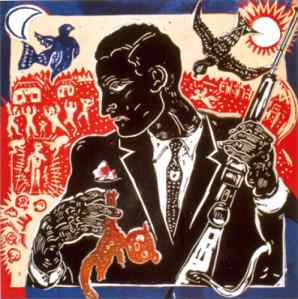

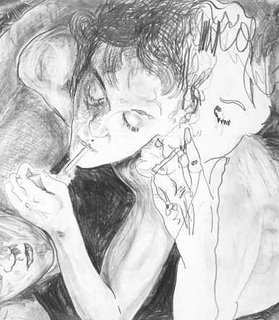
Drawing always was and still is our first language of communication as we grow. Culturally drawing still provides a means of expressing the values and nature of a people. The first humans made images to document their history and as a means to retell their experiences and to fulfil a deep set need to describe and connect to the world around them. As a consequence of making an image most of us inadvertently reveal a personal imprint of ourselves. My work for this project has allowed be to explore the kind of process I naturally use to make descriptive marks in ways that are substantially different from other artists, a kind of finger print of hand and mind. The project has also been a chance to work with other makers and that is a rare thing for many artists. The subject/theme of this project has altered your drawing process in that i have had to consider the process I use.
I would like to find ways of being more collaborative and further develop links to my peers, I have enjoyed the input they have had on the work so far. This has included the many view points seen at IMMA symposium which is something we sould revisit. I would like to see a series of collaborative outcome from this group including a book or site that explored the differences in approaches - this is something other makers of art always ask about.
Wednesday, October 04, 2006
Yijia Wang (DIT) Triptych Project
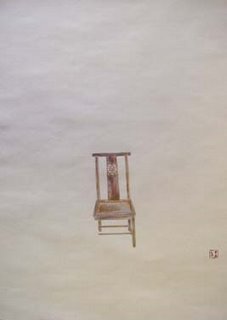
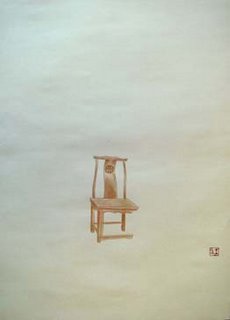

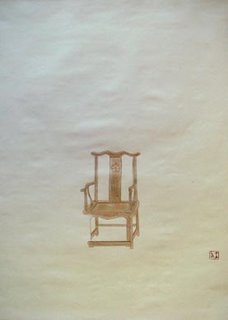
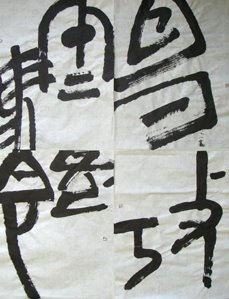
The first group of pictures is about the °ÆJia Gu°Ø words. This is a special word from old traditional Chinese words. Most word°Øs shapes were from the means by themselves. People get communicated visually to describe what they observed. My responses to ßQ were °Æspace°Ø. In Chinese calligraphy, space was one of the very important ingredients. Sometimes people attended blank rather than the words selves. So I used the words that add some transmutation in order to display the special place.
The second group of pictures is about the °Æchair°Ø. One of the old chairs existed in vast seas of wax-covered paper without souls. They quietly lie on the paper to convey calm and contemplative. Another of my responses to ßQ was °Æjust a ghost of instability in the stability°Ø. As far as we know, triangle is the most stability figure. But anything didn°Øt exist absolute stability. I want to find a ghost of instability and to strengthen it. So I used the rosewood chair from the Ming dynasty. These the most firm chair when lost one leg gives people another feelings.
yijia wang
drawing as a language of communication
I am interesting in researching the essential role of drawing as our first language of communication . I explore this through practice of drawing and making work. I see drawing as a very powerful process in art and design. Culturally drawing still provides a means of expressing the values and nature of a people. The first humans made images to document their history and as a means to retell their experiences and to fulfil a deep set need to describe and connect to the world around them. As a consequence of making an image most of us inadvertently reveal a personal imprint of ourselves. My own research shows that from the very beginning of their course, every student draws/makes descriptive marks in ways that are substantially different from that of their peers. My own observations and research builds on that conducted by Dr Sperry, Dr B Edwards at CAL TEC and Vilayanur S Ramachandran Fellow of All Souls, Oxford. Findings confirm that the act of making a drawing engages the mind in ways that reveal different and complex aspects of consciousness, social function, identity and expression. Picasso said: "Art is the lie that reveals the truth". Yet drawing has never been fully understood and the subject is not seen as particularly important. This project shows how drawing can be developed not just as a tool of self-expression, for a number of artists from different backgrounds. the work here is quite different but the drawing still remains an important carrier for mass communication. And for me I think it offers a is a strong counter to the globalising influence of impersonal corporate mass media.
Alastair C. Adams Triptych Response
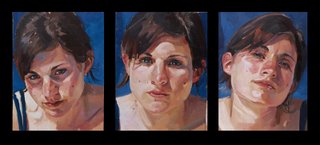
Research for me is essentially based around issues surrounding the production of painted portraits, how they can convey issues relating to character, what they say about the person who paints them and how the process can cause those involved to identify with the experiences and emotions that construct their identity. Further to the initial launch of Triptych and discussions held in conjunction with Dublin Institute of Technology and Kingston University at the Irish Museum of Modern Art in Dublin, I was presented with an opportunity to identify with areas within my own emerging research profile and produce outcomes. Being in my first year of probation in a research based position at Loughborough University, I am currently involved in developing a practice based research agenda and responses to the Triptych impetus are, for me, an opportunity to explore the production of painted outcomes lead by a research context. Although DTI’s starting point within the Triptych framework was to respond to existing imagery I have decided to take the opportunity to identify and explore themes within my own work that can be placed within a painted, three panel based format.
When dealing with issues regarding engagement, contact, power, threat and isolation in solo portraiture images are inclined, by their very nature, to become singular, stand alone pieces. Responses to the direct level of engagement that these paintings offer and require are instinctive and “primeval”. Viewers have a gut feeling that, unless already versed, is hard to verbally communicate. This may be because they are addressing an inherently visual situation however without the benefit of contrasting imagery there is no opportunity to triangulate and develop a detailed viewpoint and understanding. Is it possible then that by viewing paintings in sequence the observer is allowed an insight into the potential manipulation of character, or at least shown several sides to the same personality. Within portraiture this manipulation by the artist is a powerful tool and can imbue the subject with desired, or un-desired qualities. These qualities can then convey to a viewer character, manner, attitude and identity, which inevitably lead to reflection upon the subject as an individual. In all the purpose of the production of a portrait, rather than being the physical reproduction of a likeness becomes a process that causes the viewer to identify with issues relating to the subjects past, present and future. If this is so then by turning the viewpoint around and giving partial ownership of the production to the subject, does the ongoing cathartic process re-define the required content and perceived purpose of portraits? In this way a portrait could be said to become the by-product of the process and a re justification of the content versus depiction would have to be negotiated.
With this viewpoint in mind how can this be linked to three representations of the human head? A tripych, or series of three images, could be seen as the minimum number of images required to convey the widest range of emotions. For instance, by using one as a control or normal we have two remaining opportunities to convey a positive and a negative. In it’s most traditional format the two outer panels of a triptych fold in to the centre panel, the two outer panels relating to, and being justified by, the centre panel. In this way a three outcome statement could explore non verbal communication and concequent meaning by emphasising viewpoint, mood and expression between two extremes.
The drawback of a traditional triptych format in this sense however is that it relies on the outer panels reflecting upon, and relating to, one main panel. To increase breadth it might be better to relate to three images, forming a cycle, where each has equal importance. Working from a cyclical point of view now introduces sequentially based connotations which, in turn, suggest natural rhythms and the passing of time, such as morning, noon and night. One of the greatest strengths of portraiture over conventional photography is that it allows a response to be generated over a period of time, capturing the essence of an individual by filtering relevant and irrelevant information. Would it be possible then to produce a sequence of three related portraits that identify with differing aspects of an individual’s personality, contrasted with themes associated with engagement, atmosphere and viewpoint? Can one exist without the other? Is this “filtering through time” an essential ingredient in producing incisive, quality portraiture or is it possible to use a model and imbue attributes that do not relate to them?
The production of a series of paintings such as this offers the opportunity to identify and explore issues relevant to my current practice based research framework.
Triptych: ‘∆’: Reflecting on Drawing Practice as Knowledge
1. Has working on this subject/theme altered your drawing process in any way?
It has allowed me the opportunity to consider and explore the interaction of multiples further. Producing an out come as the result of developing a text around a theoretical point of view rather than a visual point of view
Is also new to me
2. Has the idea of a possible collaborative outcome altered your thinking/working methods in any way?
I believe the possibility of a collaborative outcome with another generates images with a greater clarity of intent and direction. Further collaborations could stimulate yet greater outcomes.
3. How has the experience of your practice being reviewed and viewed by your peers in Triptych influenced the work?
This has not happened yet.
4. Have you discussed this piece of work/process with anyone else in Triptych while carrying out the work?
No.
5. Has anything you saw at the Triptych IMMA symposium influenced your thinking or process in any way?
The diversity of outcomes at the Triptych IMMA event has made me stronger and more determined to pursue work that identifies further with personal strengths and themes evident in my work.
6. What collaborative outcome would you suggest as being appropriate for this research group?
Exhibition and publication.
Monday, October 02, 2006
Siún Hanrahan, Triptych Project
Tri-Angle
One of my responses to ∆ was ‘tri-angle’ – three angles or points of view. It offers a sense of the limits of dia-logue… The polarity of two risks the illusion that the full range of possibility is somehow captured in the space between them. Three marks the impossibility of this; it suggests différance.
A Tale of Bread, 2005

This piece explores the idea of conversation (rather than dialogue) and unfolded from the idea that: Bread is connectedness and communion and Conversation is connectedness and communion. Conversation is central to meaning as meaning emerges in the encounter with others. It is in and through conversation that identity is constructed.
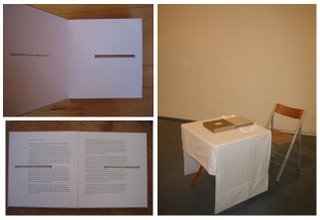
A Tale of Bread takes the form of a book in three parts – Milling, Baking and Eating. Each part is built around a key moment in the tale of bread, from the processes by which it is made to the process by which it is consumed, and explores the intercourse of self and other in the emergence of meaning.
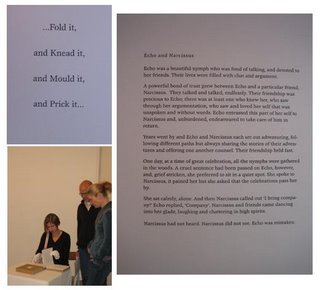
Some tales are told across all three parts and some belong to one part only. What is sought is a playful kneading of ideas, a kneading enacted within and between chapters.
Triúr: Elias, Benhabib and Burgess, a work in progress
The idea of three points of view (tri-angle) suggested a rather arbitrary beginning: the three books I have read most recently. Each of which is connected in a loose way with one question, 'how do I account for what is shared in meaning making?'
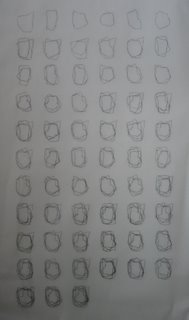 Book I, Elias, offers some sense of the perspective offered by Elias, in his book The Society of Individuals, overlaid upon images drawn from previous work lifted into attention by Elias's metaphors.
Book I, Elias, offers some sense of the perspective offered by Elias, in his book The Society of Individuals, overlaid upon images drawn from previous work lifted into attention by Elias's metaphors.
Book II, Benhabib, will be like Book I in that its form will be determined in response to Benhabib's book The Situated Self.
Book III, Burgess (as for Benhabib).
One of my responses to ∆ was ‘tri-angle’ – three angles or points of view. It offers a sense of the limits of dia-logue… The polarity of two risks the illusion that the full range of possibility is somehow captured in the space between them. Three marks the impossibility of this; it suggests différance.
A Tale of Bread, 2005

This piece explores the idea of conversation (rather than dialogue) and unfolded from the idea that: Bread is connectedness and communion and Conversation is connectedness and communion. Conversation is central to meaning as meaning emerges in the encounter with others. It is in and through conversation that identity is constructed.

A Tale of Bread takes the form of a book in three parts – Milling, Baking and Eating. Each part is built around a key moment in the tale of bread, from the processes by which it is made to the process by which it is consumed, and explores the intercourse of self and other in the emergence of meaning.

Some tales are told across all three parts and some belong to one part only. What is sought is a playful kneading of ideas, a kneading enacted within and between chapters.
Triúr: Elias, Benhabib and Burgess, a work in progress
The idea of three points of view (tri-angle) suggested a rather arbitrary beginning: the three books I have read most recently. Each of which is connected in a loose way with one question, 'how do I account for what is shared in meaning making?'
 Book I, Elias, offers some sense of the perspective offered by Elias, in his book The Society of Individuals, overlaid upon images drawn from previous work lifted into attention by Elias's metaphors.
Book I, Elias, offers some sense of the perspective offered by Elias, in his book The Society of Individuals, overlaid upon images drawn from previous work lifted into attention by Elias's metaphors.Book II, Benhabib, will be like Book I in that its form will be determined in response to Benhabib's book The Situated Self.
Book III, Burgess (as for Benhabib).

